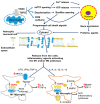Diagnostic and Therapeutic Potential of TSPO Studies Regarding Neurodegenerative Diseases, Psychiatric Disorders, Alcohol Use Disorders, Traumatic Brain Injury, and Stroke: An Update
- PMID: 32252470
- PMCID: PMC7226777
- DOI: 10.3390/cells9040870
Diagnostic and Therapeutic Potential of TSPO Studies Regarding Neurodegenerative Diseases, Psychiatric Disorders, Alcohol Use Disorders, Traumatic Brain Injury, and Stroke: An Update
Abstract
Neuroinflammation and cell death are among the common symptoms of many central nervous system diseases and injuries. Neuroinflammation and programmed cell death of the various cell types in the brain appear to be part of these disorders, and characteristic for each cell type, including neurons and glia cells. Concerning the effects of 18-kDa translocator protein (TSPO) on glial activation, as well as being associated with neuronal cell death, as a response mechanism to oxidative stress, the changes of its expression assayed with the aid of TSPO-specific positron emission tomography (PET) tracers' uptake could also offer evidence for following the pathogenesis of these disorders. This could potentially increase the number of diagnostic tests to accurately establish the stadium and development of the disease in question. Nonetheless, the differences in results regarding TSPO PET signals of first and second generations of tracers measured in patients with neurological disorders versus healthy controls indicate that we still have to understand more regarding TSPO characteristics. Expanding on investigations regarding the neuroprotective and healing effects of TSPO ligands could also contribute to a better understanding of the therapeutic potential of TSPO activity for brain damage due to brain injury and disease. Studies so far have directed attention to the effects on neurons and glia, and processes, such as death, inflammation, and regeneration. It is definitely worthwhile to drive such studies forward. From recent research it also appears that TSPO ligands, such as PK11195, Etifoxine, Emapunil, and 2-Cl-MGV-1, demonstrate the potential of targeting TSPO for treatments of brain diseases and disorders.
Keywords: PET tracing; TSPO; astrocytes; brain disease; brain disorders; cell death; drug development; microglia; microglia activation; neurons; regeneration.
Conflict of interest statement
The authors declare no conflict of interest.
Figures




Similar articles
-
TSPO Ligand 2-Cl-MGV-1 Mitigates Traumatic Brain Injury (TBI) in a Mouse Model.Int J Mol Sci. 2025 May 19;26(10):4854. doi: 10.3390/ijms26104854. Int J Mol Sci. 2025. PMID: 40429994 Free PMC article.
-
The 18-kDa Translocator Protein as a CNS Drug Target: Finding Our Way Through the Neuroinflammation Fog.CNS Neurol Disord Drug Targets. 2017;16(9):990-999. doi: 10.2174/1871527316666171004125107. CNS Neurol Disord Drug Targets. 2017. PMID: 28982340 Review.
-
Upregulation of cannabinoid receptor type 2, but not TSPO, in senescence-accelerated neuroinflammation in mice: a positron emission tomography study.J Neuroinflammation. 2019 Nov 10;16(1):208. doi: 10.1186/s12974-019-1604-3. J Neuroinflammation. 2019. PMID: 31707986 Free PMC article.
-
TSPO in diverse CNS pathologies and psychiatric disease: A critical review and a way forward.Pharmacol Ther. 2019 Feb;194:44-58. doi: 10.1016/j.pharmthera.2018.09.003. Epub 2018 Sep 4. Pharmacol Ther. 2019. PMID: 30189290 Free PMC article. Review.
-
Translocator Protein-18 kDa (TSPO) Positron Emission Tomography (PET) Imaging and Its Clinical Impact in Neurodegenerative Diseases.Int J Mol Sci. 2017 Apr 7;18(4):785. doi: 10.3390/ijms18040785. Int J Mol Sci. 2017. PMID: 28387722 Free PMC article. Review.
Cited by
-
Neuroprotective Function of Rasagiline and Selegiline, Inhibitors of Type B Monoamine Oxidase, and Role of Monoamine Oxidases in Synucleinopathies.Int J Mol Sci. 2022 Sep 21;23(19):11059. doi: 10.3390/ijms231911059. Int J Mol Sci. 2022. PMID: 36232361 Free PMC article. Review.
-
Evaluation of (R)-[11C]PK11195 PET/MRI for Spinal Cord-Related Neuropathic Pain in Patients with Cervical Spinal Disorders.J Clin Med. 2022 Dec 23;12(1):116. doi: 10.3390/jcm12010116. J Clin Med. 2022. PMID: 36614916 Free PMC article.
-
The role of neuroimaging in Parkinson's disease.J Neurochem. 2021 Nov;159(4):660-689. doi: 10.1111/jnc.15516. Epub 2021 Oct 3. J Neurochem. 2021. PMID: 34532856 Free PMC article. Review.
-
A novel blood-free analytical framework for the quantification of neuroinflammatory load from TSPO PET Imaging.Res Sq [Preprint]. 2025 Feb 3:rs.3.rs-5924801. doi: 10.21203/rs.3.rs-5924801/v1. Res Sq. 2025. Update in: J Cereb Blood Flow Metab. 2025 Jul 31:271678X251361261. doi: 10.1177/0271678X251361261. PMID: 39975931 Free PMC article. Updated. Preprint.
-
The Interplay of Cholesterol and Ligand Binding in hTSPO from Classical Molecular Dynamics Simulations.Molecules. 2021 Feb 26;26(5):1250. doi: 10.3390/molecules26051250. Molecules. 2021. PMID: 33652554 Free PMC article.
References
-
- Gavish M., Bachman I., Shoukrun R., Katz Y., Veenman L., Weisinger G., Weizman A. Enigma of the peripheral benzodiazepine receptor. Pharmacol. Rev. 1999;51:629–650. - PubMed
-
- Dimitrova-Shumkovska J., Veenman L., Ristoski T., Leschiner S., Gavish M. Dimethylbenz[alpha]anthracene induces oxidative stress and reduces the binding capacity of the mitochondrial 18-kDa translocator protein in rat aorta. Drug Chem. Toxicol. 2010;33:337–347. doi: 10.3109/01480540903483441. - DOI - PubMed
Publication types
MeSH terms
Substances
LinkOut - more resources
Full Text Sources
Medical

